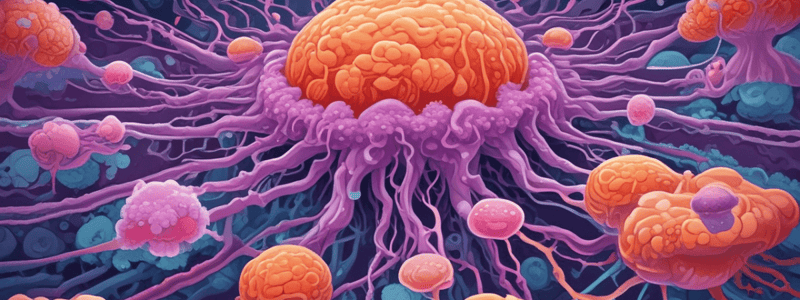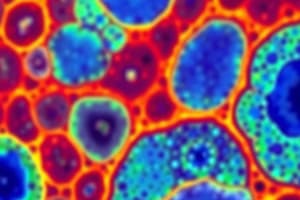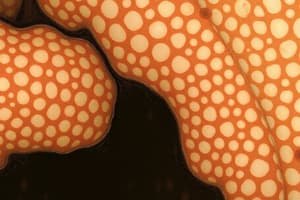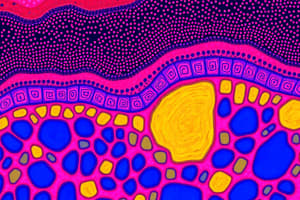Podcast
Questions and Answers
What type of Ehlers Danlos syndrome is caused by mutations in Type III collagen?
What type of Ehlers Danlos syndrome is caused by mutations in Type III collagen?
- Type I
- Type IV (correct)
- Type II
- Type III
What is the primary function of elastic fibers in connective tissue?
What is the primary function of elastic fibers in connective tissue?
- Confer elasticity (correct)
- Provide strength to the tissues
- Facilitate cell migration
- Store energy
What is the role of fibrillin in relation to elastic fibers?
What is the role of fibrillin in relation to elastic fibers?
- It enhances tensile strength
- It provides hydration to the fibers
- It acts as a structural component (correct)
- It degrades damaged fibers
Which of the following conditions results from a genetic defect in fibrillin?
Which of the following conditions results from a genetic defect in fibrillin?
What is the main composition of the ground substance in connective tissue?
What is the main composition of the ground substance in connective tissue?
How does the structure of elastin contribute to its elasticity?
How does the structure of elastin contribute to its elasticity?
What serious condition can result from defects in elastic fibers due to Marfan's syndrome?
What serious condition can result from defects in elastic fibers due to Marfan's syndrome?
What molecules are primarily embedded in the gel-like matrix of the ground substance?
What molecules are primarily embedded in the gel-like matrix of the ground substance?
What is the main characteristic of epithelial cell polarity?
What is the main characteristic of epithelial cell polarity?
What is the function of the basal lamina in epithelial cells?
What is the function of the basal lamina in epithelial cells?
Which of the following structures are formed on the basal plasma membrane of epithelial cells?
Which of the following structures are formed on the basal plasma membrane of epithelial cells?
Which of the following best describes the role of tight junctions in epithelial cells?
Which of the following best describes the role of tight junctions in epithelial cells?
Where do the lateral surfaces of epithelial cells primarily face?
Where do the lateral surfaces of epithelial cells primarily face?
What is a key function of the apical domain in epithelial cells?
What is a key function of the apical domain in epithelial cells?
How do epithelial cells primarily maintain their structural integrity?
How do epithelial cells primarily maintain their structural integrity?
What defines the basal surface of epithelial cells?
What defines the basal surface of epithelial cells?
What is the primary component of connective tissue that differentiates it from epithelium?
What is the primary component of connective tissue that differentiates it from epithelium?
Which type of collagen is the most abundant in connective tissue proper?
Which type of collagen is the most abundant in connective tissue proper?
What aspect of connective tissue is primarily provided by collagen fibers?
What aspect of connective tissue is primarily provided by collagen fibers?
What is the primary role of fibroblasts in connective tissue?
What is the primary role of fibroblasts in connective tissue?
Which statement regarding the extracellular matrix of connective tissue is true?
Which statement regarding the extracellular matrix of connective tissue is true?
What characteristic distinguishes elastic fibers in connective tissue?
What characteristic distinguishes elastic fibers in connective tissue?
How many different types of collagen are there in total?
How many different types of collagen are there in total?
What is the visible form of Type I collagen in histological sections?
What is the visible form of Type I collagen in histological sections?
What are the repeating units called that make up the ordered arrangement of contractile proteins in muscle fibers?
What are the repeating units called that make up the ordered arrangement of contractile proteins in muscle fibers?
What type of tissue surrounds each muscle fiber?
What type of tissue surrounds each muscle fiber?
Where are satellite cells located in relation to muscle fibers?
Where are satellite cells located in relation to muscle fibers?
What can activate satellite cells within muscle tissue?
What can activate satellite cells within muscle tissue?
What characterizes cardiac muscle compared to skeletal muscle?
What characterizes cardiac muscle compared to skeletal muscle?
Which structures run alongside muscle fibers within the connective tissue?
Which structures run alongside muscle fibers within the connective tissue?
What happens to satellite cells after muscle injury?
What happens to satellite cells after muscle injury?
In which locations is cardiac muscle found?
In which locations is cardiac muscle found?
What is the primary role of mast cells in the inflammatory response?
What is the primary role of mast cells in the inflammatory response?
Which component is not found in the secretory granules of mast cells?
Which component is not found in the secretory granules of mast cells?
What triggers mast cell degranulation in response to allergens?
What triggers mast cell degranulation in response to allergens?
What is the primary function of plasma cells?
What is the primary function of plasma cells?
What is a key feature of white blood cells in connective tissue?
What is a key feature of white blood cells in connective tissue?
Which white blood cell differentiates into macrophages in tissues?
Which white blood cell differentiates into macrophages in tissues?
Which of the following is NOT a type of white blood cell mentioned?
Which of the following is NOT a type of white blood cell mentioned?
During chronic inflammation, what happens to plasma cell numbers?
During chronic inflammation, what happens to plasma cell numbers?
Flashcards are hidden until you start studying
Study Notes
Characteristics of Epithelia
- Epithelial cells exhibit polarity with distinct apical, lateral, and basal surfaces, facilitating directional transport.
- The basal surface interacts with connective tissue and is anchored to the basal lamina, a glycoprotein layer.
- Basal surface specializations include adherens junctions and hemidesmosomes for enhanced attachment to the extracellular matrix.
Epithelial Cell Junctions
- Lateral surfaces host intercellular junctions; the tight junction (zonula occludens) is crucial for sealing gaps between cells, preventing the passage of fluids and molecules.
Extracellular Matrix in Connective Tissue
- In connective tissue, extracellular matrix predominates over cells, composed of fibers and ground substance.
- Collagen, particularly Type I and Type III, provides tensile strength; Type I collagen is the most abundant protein in the body.
- Mutations in Type III collagen are associated with Ehlers-Danlos syndrome, impacting organ structural integrity.
Fiber Types in Connective Tissue
- Elastic fibers, synthesized by fibroblasts and smooth muscle, provide elasticity; their formation involves tropoelastin and the glycoprotein fibrillin.
- Marfan's syndrome results from fibrillin defects, leading to issues with elastic fibers, notably in the aorta.
Ground Substance Composition
- Ground substance consists primarily of proteoglycans and hyaluronan, facilitating cell migration and differentiation through adhesive glycoproteins.
Mast Cells
- Derived from bone marrow stem cells, mast cells are found near blood vessels and release histamine and other mediators during inflammatory responses.
- They play a key role in allergic reactions, including anaphylaxis, by increasing vascular permeability and causing edema.
Plasma Cells
- Plasma cells develop from activated B lymphocytes in connective tissue and are responsible for antibody secretion, especially during chronic inflammation.
White Blood Cells in Connective Tissue
- Leukocytes, including neutrophils and macrophages, originate from bone marrow, circulating in blood and migrating into tissues to perform immune functions.
- The immune response involves mechanisms that allow these cells to exit blood vessels and infiltrate surrounding tissues.
Muscle Cell Structure
- Each muscle fiber features a sheath with a basal lamina and associated connective tissue, housing small blood vessels and nerves.
- Satellite cells, which possess stem cell-like qualities, can be activated for muscle repair after injury or intense exercise.
Cardiac Muscle Characteristics
- Cardiac muscle is involuntary, providing consistent, strong contractions and is exclusively found in the heart and pulmonary veins.
- It forms the primary structure of the heart, essential for its pumping function.
Studying That Suits You
Use AI to generate personalized quizzes and flashcards to suit your learning preferences.




